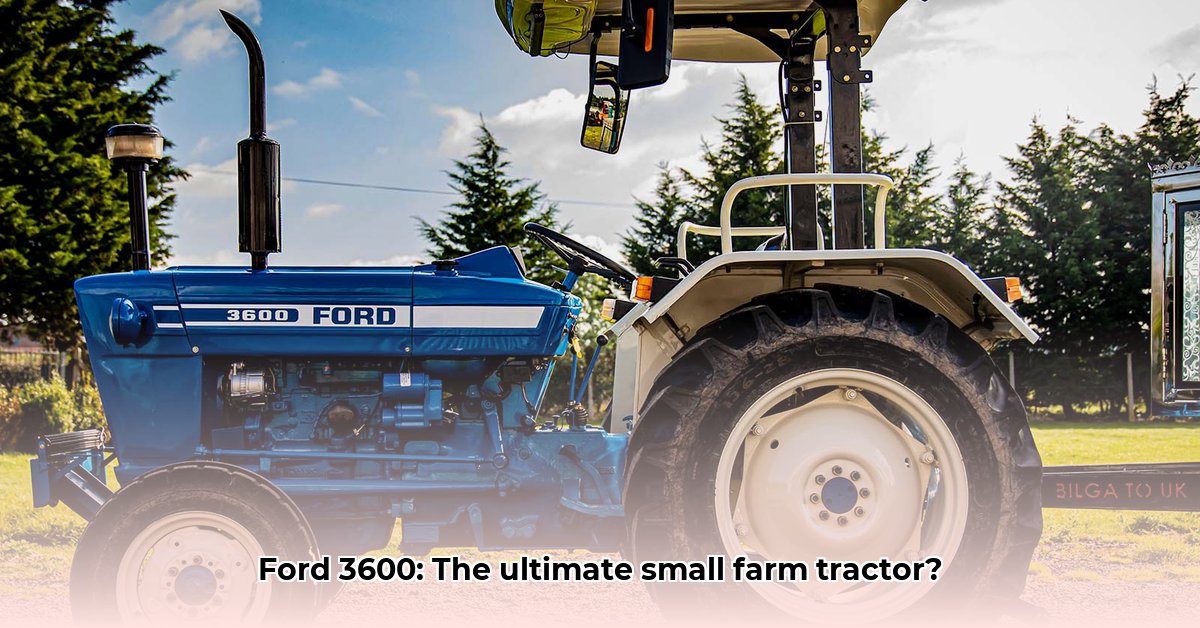
The Ford 3600 Tractor: A Sustainable Choice for Small Farms?
The Ford 3600, a stalwart of the 1970s farming landscape, is experiencing a resurgence among farmers prioritizing sustainable agriculture. This isn't simply nostalgia; the 3600's specifications offer compelling advantages for environmentally conscious farming practices. But is it the right fit for your farm? This article delves into its specifications, compares it to modern equivalents, and explores its potential role within a sustainable farming strategy. For detailed specifications, check out this helpful resource: Ford 3600 Specs.
We'll examine its fuel efficiency, maintenance needs, technological limitations, and how these factors contribute – or detract – from its overall environmental impact. Ultimately, we’ll equip you with the information you need to assess whether a Ford 3600 is the sustainable solution your farm requires.
Ford 3600 Specifications and Sustainable Farming Principles
The Ford 3600, produced between 1975 and 1981, boasts a relatively modest 45-48 horsepower. While this might seem underwhelming compared to today's powerful tractors, it presents a significant advantage for sustainable farming: lower fuel consumption. "Lower horsepower translates directly into reduced greenhouse gas emissions," explains Dr. Emily Carter, Agricultural Engineer at the University of California, Davis. "This is a crucial factor for farmers aiming to minimize their carbon footprint."
This lower fuel consumption also translates directly into cost savings. But how do these savings compare to the potentially slower work rate? This is an important consideration when comparing to modern, higher-horsepower counterparts.
Key Specifications:
- Horsepower: 45-48 hp
- Fuel Efficiency: Relatively high for its era (precise figures vary depending on usage and condition)
- Maintenance: Relatively simple mechanical design; fewer electronic components
- Technological Features: Basic; lacks advanced precision farming technologies such as GPS guidance.
Maintenance and Repair: A Sustainable Advantage?
The 3600's simple mechanical design is another key factor contributing to its sustainability profile. "The simplicity of the 3600 is a significant advantage," notes John Miller, owner of Miller's Repair, a family-run farm equipment repair shop in Iowa. "Fewer electronic components mean fewer potential points of failure, and repairs are generally less complex and less expensive." This makes it more accessible to farmers who value affordability and self-sufficiency in maintenance. However, the availability of parts is naturally a concern with a machine of this age. Careful consideration of parts sourcing is crucial before commitment.
Is this simplicity and ease of repair offset by higher frequency of repairs over the lifetime of a more modern equivalent? This is a comparison that needs careful consideration.
Comparing the Ford 3600 to Modern Tractors
How does the Ford 3600 stack up against modern tractors in a side-by-side comparison? The table below highlights key differences and considerations:
| Feature | Ford 3600 | Modern Equivalent (e.g., 50-60 hp) | Considerations |
|---|---|---|---|
| Horsepower | 45-48 hp | 50-60 hp | Higher horsepower means increased fuel consumption and potentially higher initial cost. |
| Fuel Efficiency | Relatively high for its era | Generally higher, but often at a higher purchase price | Consider the total cost of ownership over the tractor's lifetime. |
| Maintenance | Simpler, less costly | More complex, potentially higher repair costs | Weigh the trade-off between simpler repairs and potential increased frequency of repairs on older models. |
| Technology | Basic | Advanced features (GPS, automated systems) | Assess the value of advanced features against their complexity and cost. |
| Initial Cost | Significantly lower | Significantly higher | The lower initial purchase price of a used 3600 can be very significant. |
Beyond Fuel Consumption: A Holistic Approach to Sustainability
Assessing the environmental impact of the Ford 3600 extends beyond simple fuel consumption. We need to consider the entire lifecycle:
- Manufacturing: The embodied energy (energy used to manufacture the tractor) is significantly lower for a vintage tractor.
- Operation: While fuel efficiency is a factor, so is the overall lifespan and productivity. A longer-lasting tractor, even with slightly higher fuel consumption, may have a lower overall environmental impact compared to more frequent replacements.
- Maintenance & Repair: Easier repair is more sustainable in terms of material use and waste production. Sourcing parts from recycling and repurposing networks can significantly enhance its sustainability profile.
- End-of-Life: Proper disposal or recycling at the end of its lifespan is essential.
Actionable Steps: Assessing the Ford 3600 for Your Farm
Considering a Ford 3600 for your small farm requires careful consideration of your specific needs:
- Assess your workload: Can the 3600's lower horsepower handle your farming tasks efficiently?
- Evaluate maintenance capabilities: Do you have the skills or access to a mechanic for repairs?
- Explore parts availability: Can you reliably source parts in your region?
- Compare total cost of ownership: Factor in fuel, maintenance, and potential repair costs over the tractor's lifespan.
- Consider your sustainability goals: How important is fuel efficiency relative to other factors like initial cost and ease of repair?
The Ford 3600 represents a viable pathway toward sustainable agriculture for some small farms. By carefully weighing the above factors against your farm’s unique circumstances, you can determine if this vintage tractor is a sustainable solution for your operation. Remember, sustainable agriculture is a holistic endeavor, factoring in ecological, economic, and social considerations.